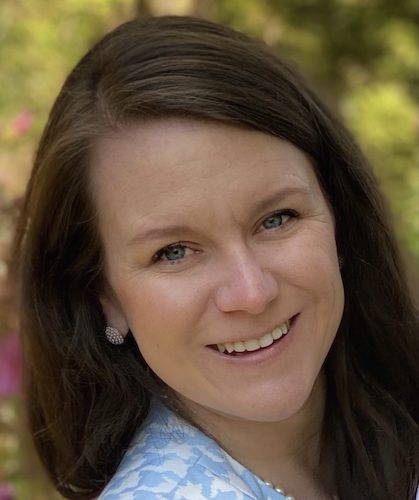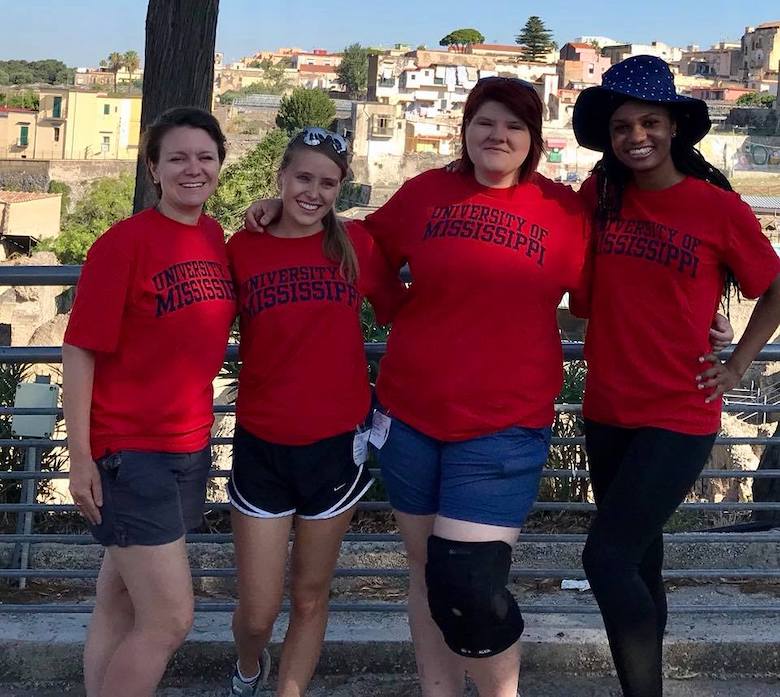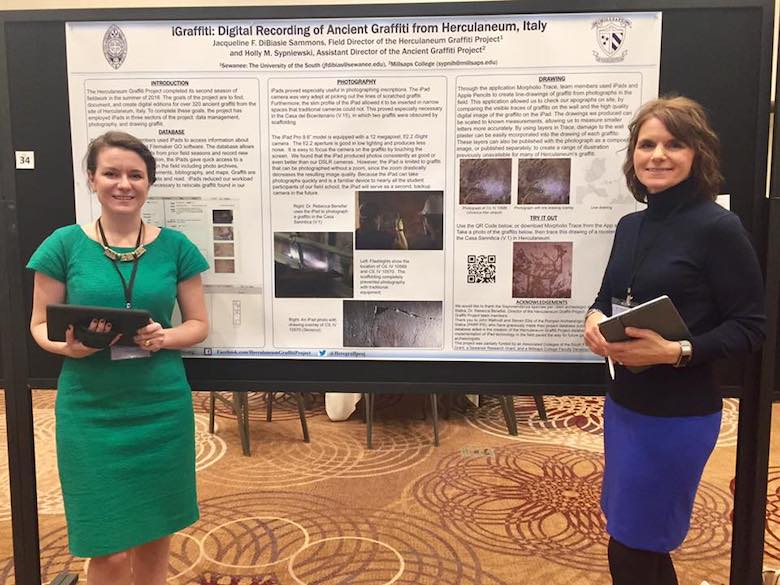
Jacqueline DiBiasie-Sammons, assistant professor of classics. Submitted photo
An assistant professor of classics at the University of Mississippi since 2017, Jacqueline DiBiasie-Sammons received the 2021 Dr. Mike L. Edmonds New Scholar Award in Humanities from the College of Liberal Arts.
Her research investigates ancient graffiti from the Roman cities of Pompeii and Herculaneum and her work applies modern technologies to visualize and read these ancient inscriptions. Recent work has focused on charcoal graffiti, which she studied using the field notebooks of one of the original excavators of ancient Herculaneum. Only a handful of charcoal graffiti are still extant at the archaeological sites, so the field notebooks hold precious clues into this once-ubiquitous type of ancient inscription.
“Though separated from us by nearly 2,000 years, the ancient Romans expressed many of the same desires, hopes, and fears that we do today. Understanding ancient graffiti helps us understand a bit more about ourselves, too.”
Briefly describe your teaching philosophy. What should people know about it?
I strive to make the ancient world come alive for my students through active learning and student-centered approaches. It is important to me that my students not only master the content of the class but leave with a passion for the ancient world and an understanding of the importance of its study. My ideal classroom is a vibrant one, in which students feel comfortable grappling with the material and asking questions of it and of me. For that reason, I regularly employ problem-solving activities, collaborative exercises, and games. My Latin classes routinely play games like Latin Bingo, Battleship and Apples to Apples. These games reinforce the grammatical concepts and help students make connections between Latin and English. I also believe I have a responsibility to reinforce the applicability of material from the ancient world to today’s society. I ask my Latin students in the final reflection paper to think about the ways they will use Latin in their future course of study and career. In my Ancient Cities course, students write an opinion paper about the destruction of the city of Palmyra. Students are asked to consider “who owns the past?” By focusing on skills as well as content, students can see a benefit to their learning even if they are not considering a career in Classics.
How did your interest in your field of study develop? What initially sparked your interest in teaching about your area?
I have been interested in archaeology and the past since I was little (I share my birthdate with the date of the eruption of Mt. Vesuvius that buried Pompeii in 79 AD), but did not consider Classics as an area of study until college. There, wonderful professors nurtured my budding interests in archaeology and Latin and involved me in their research. In college, I participated in a peer tutoring program. While helping my peers learn Latin, I realized that I felt called to the teaching vocation and helping others. My favorite part of teaching is seeing students “get it” and start to love Latin and Classics as much as I do.

Dr. DiBiasie-Sammons (left) and Classics students in ancient Herculaneum as part of the Ancient Graffiti Project.
In reflecting on your time as a professor, what are the highlights?
My favorite teaching memories have involved travel with students in Italy. In 2019, I led a study abroad trip to Rome and the Bay of Naples. Nine intrepid students and I explored many of the ancient sites while enjoying the Italian la bella vita. The students were excited to visit the places they had read about and studied for so long. It was fascinating to watch as their understanding of the ancient sites changed when they could see them in person. I also took students to Italy in 2018 and 2019 to participate in the Ancient Graffiti Project. Students on the project documented and studied ancient graffiti in the Roman cities of Pompeii and Herculaneum. As these students can attest, there is nothing more exciting than finding a piece of ancient writing scribbled on the walls by a Pompeian nearly 2,000 years ago—it is an unforgettable experience. The Department of Classics’ McDonnell Endowment has made study abroad possible for many of our students.
A highlight of my research activities is a trip I took to the Getty Research Institute in 2019. There, I studied the archaeological field notebooks of Matteo Della Corte, the epigrapher who first documented graffiti from Herculaneum. Many of these graffiti have no published drawings that show us what they looked like, so it was incredibly exciting to see how they appeared for the first time. None of these charcoal graffiti are extant, so the notebook drawings are all that remains of their visual appearance. My recent work reexamines the charcoal graffiti of Herculaneum using these field notebooks.
Are there specific examples of support—fellowships, mentoring, other—that helped advance your academic and professional goals?
I have been fortunate to have excellent mentors, especially Dr. Rebecca Benefiel (Washington and Lee University) and Dr. Holly Sypniewski (Millsaps College), who have encouraged me in the field and involved me in their research. My colleagues in the Department of Classics have encouraged my research activities and supported student involvement in my research and travel to Italy. Travel stipends from UM have facilitated travel to conferences in the US and in Italy, which has allowed me to meet with other scholars in my research area. Recently, UM supported a symposium I co-organized in Italy (Symposium Campanum). This symposium brought together more than twenty scholars from around the globe and allowed me to present my newest research ideas to this distinguished audience. I have also been supported by several Center for Excellence in Teaching and Learning (CETL) grants. This wonderful resource on our campus provides many opportunities to enhance our teaching and learn new techniques.

Dr. DiBiasie-Sammons presents a poster with Dr. Holly Sypniewski, a professor of classics at Millsaps College, at the annual meeting of the Archaeological Institute of America.
What do you hope students take away from your classes?
I teach both archaeology and language, but in both disciplines I want my students to make connections. I want the archaeology students to make connections between artifacts or monuments of different time periods. In Roman Archaeology, we think about how later monuments emulate, compete with, or respond to earlier monuments. Likewise, we discuss how contemporary American monuments make use of ancient sources and the reasons behind Classical reception in modern times. In Latin classes, students make connections between the Latin language and English or other Romance languages. Many of my students tell me that their study of Latin has clarified shaky grammatical concepts in English. Connections between Latin and English vocabulary help the students to understand both languages.
I also want students to leave my classes better students. In the language courses, we discuss strategies to study vocabulary, memorize grammatical forms, and prepare for exams. In Ancient Cities, which is a 100-level introductory course, we talk about note-taking strategies, which we practice together.
I strive to ensure that students leave my classes engaged with the material, excited about the ancient world, and with a clear sense of how the study of it has benefited them in the present and will do so in the future.
Do you have advice or thoughts to share with students?
Broaden your horizons! Take as many courses outside your major as you can. Even if you do not pursue the subject for a career, you may find a new passion or interest that you can continue to explore throughout your life. Use your time in college to stretch yourself outside your comfort zone and take advantage of all our university has to offer. Likewise, study abroad! Exploring another country will broaden your outlook and give you a new perspective.